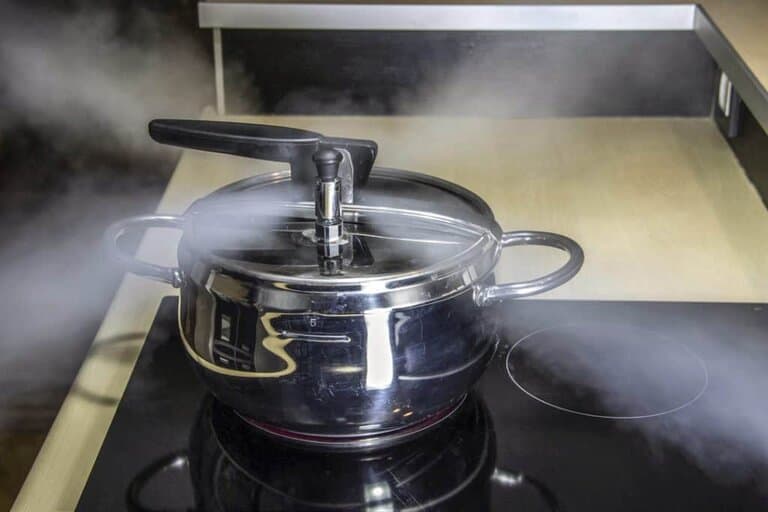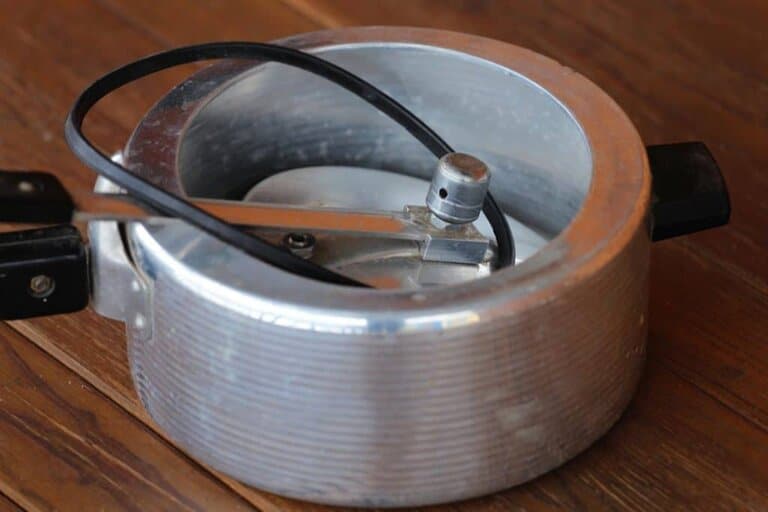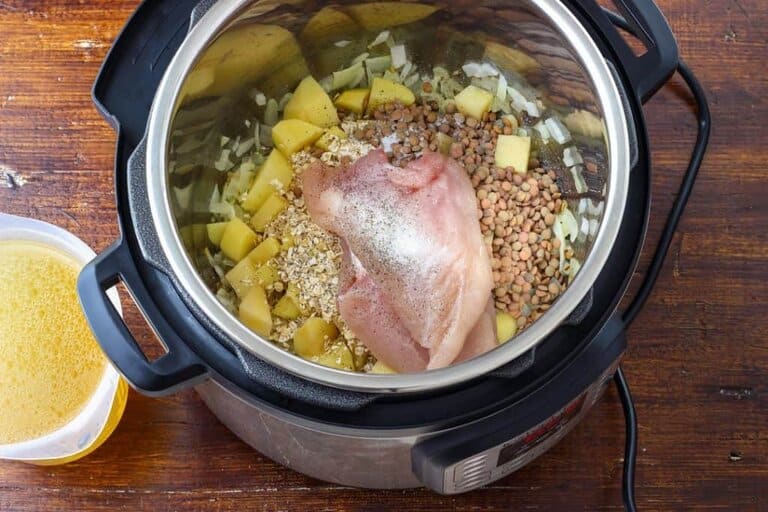A dirty or damaged gasket, an improperly closed or dented lid, overfilled cooker, and a damaged cooker are the most common causes of steam leaking from the side of a pressure cooker.
Pressure cookers are a lifesaver. This inexpensive kitchen gadget has greatly simplified my cooking and takes a lot of pressure off of me when I try to find a quick meal.
However, It’s a bummer when it causes problems. I wish it could always work as well as it did when I first got it. But, I guess that’s just how it is with every home appliance; there’s always something to fix after some time.
If you use an electric pressure cooker (instant pot) or a stovetop pressure cooker, you may have to deal with some pressure cooking issues such as leaking steam.
A pressure cooker that leaks is not only messy, but it will also slow down the cooking process and affect the outcome of your meal.
Fortunately, this particular pressure cooker problem isn’t hard to fix. Once you know why the steam is escaping, you are one step closer to resolving the issue and enjoying an excellent pressure-cooked meal again.
Below are six reasons why steam comes out of the side of your pressure cooker and how to fix them. This will save you tons of time and frustration.

Why Your Pressure Cooker Is Leaking Steam From The Side
While a small amount of steam escaping from the valve (the whistle on top of the lid) during cooking is normal, steam coming from the sides of the lid is not. This could mean several things, and Sometimes the problem has an easy fix, sometimes not.
Let’s look at some of the causes of your leaking pressure cooker and simple DIY methods to stop steam from coming from the sides.
Improper Lid Placement
When you notice steam coming from the side of your pressure cooker, you don’t have to panic because the cause could be as simple as your lid being in the wrong position.
Your pressure cooker must be completely sealed for the proper pressure to build when cooking. If the lid is not placed correctly, it can result in a loss of pressure inside, resulting in steam escaping from the sides of the cooker.
How To Fix This
You can simply adjust the lid and cover the pressure cooker properly. But, hold on before you do that. Below are some precautions you need to follow so you don’t get hurt!
Precautions
- Never try to adjust the lid when the pressure is on; hot steam can be quickly released on your hand or face.
- Turn the cooker off and allow it to cool before touching the lid.
Now, To close the lid;
- Firmly press it down. When the lid is locked in place, you should hear a clicking or other audible noise.
- Double-check to ensure the lid is securely closed, then turn on your pressure cooker.
Dirty or Broken Valve
It’s normal for steam to escape through the valve; however, you should be concerned when it becomes excessive.
The valve on your pressure cooker is responsible for controlling the amount of steam that escapes from your pressure cooker. So if you notice excess steam, it’s possible that your valve is broken or not tightly secured due to food buildup.
How To Fix This
- Confirm that the valve is positioned correctly on the lid.
- After each use, clean the valve on your pressure cooker to remove food residue.
- Find a replacement valve if the valve is broken.
Issues With Gasket Ring
When your pressure cooker begins to leak steam from the sides, it is most likely due to a problem with the lid rim or gasket.
The gasket is a silicon or rubber ring inside the lid. It is designed to tightly seal the lid to the cooker, locking in all moisture and allowing the proper steam level to be produced.
However, if the gasket on the lid is improperly installed, defective, or completely missing, your pressure cooker will not be able to build up enough pressure and will leak vapor from the sides of the lid.
Also, food or debris can sometimes become stuck on the gasket and form a layer on the ring, causing a gap between the cooker and lid and allowing steam to escape.

How to Repair a Leak Caused by a Gasket
Gasket ring issues are probably the most common problems pressure cooker users face, and they can be difficult to fix. However, below are some tips to keep up with repairs and maintenance.
Cleaning Tips
- First, check to see if your gasket is installed correctly
- If the gasket is simply dirty, remove it from the lid
- Then wash the gasket in cold, soapy water and allow it to dry.
If your gasket is completely missing or damaged:
- You must replace it before using the pressure cooker (A new gasket can be purchased for as little as $20 at a kitchen store or online.)
- To install the new gasket, push the gasket all the way down into the ring rack and make sure it can spin freely in the lid.
Maintenance Tips
- Because of the heat, your gasket may expand and fit loosely around the rim of the pressure cooker lid. So, consider storing your sealing gasket in the refrigerator when not in use.
- Purchase multiple gaskets for various cooking purposes to ensure lasting usage.
- Clean the gasket ring at least 3 times a week if you use the pressure cooker regularly.
- Replace your gasket annually.
Dented Cooker Edges
When cooking certain types of meals, we are more likely to hit a metal spoon on the edges of the pressure cooker, which can cause a dent.
If the cooker’s edges are damaged, it might not seal properly and could leak. And your pressure cooker will leak as a result of this.
How to Fix This
- Take your pressure cooker to a professional to repair it. They have the necessary right tools to reshape the edges.
- If the dent appears to be beyond repair, you need to buy a new pressure cooker.
Overfilling
If you exceed the recommended capacity of water or food for your pressure cooker, it may begin to release more steam, resulting in a mess around your cooking area.

How to Fix This
- Never fill your pressure cooker to the brim.
- I recommend that you only fill the cooker up to two-thirds with water and halfway with certain foods, especially those with starchy contents.
- If you are unsure about the capacity of your cooker, consult the user manual that comes with the product.
Damaged Cooker
Pressure cookers are designed to last for many years. However, they are not indestructible. Therefore, there is an excellent chance that your pressure cooker has suffered some damage over the years due to accidental falls and cracks, which could cause leakage.
How To Fix This
- Take the pressure cooker to a local repair shop for minor damages.
- Consider purchasing a newer pressure cooker model as a necessary kitchen upgrade. A more recent model will undoubtedly have better features that will make your pressure cooker more efficient and cooking more manageable for you.
- Make sure you get a high-quality pressure cooker if you want to use it for a long time. It might be a little pricey, but the investment is well worth it.
- Keep your pressure cooker or instant pot in a secure location to avoid accidental falls and cracks.
Not Enough Liquid In Pressure Cooker
Most pressure cooker models require at least one cup of liquid for each pound of food to create enough pressure to safely cook the food. If you don’t have enough liquid, the pressure cooker may not work correctly and start to steam.
How to Fix This:
- Simply check if there’s any liquid left in the bottom of your pressure cooker.
- If there is none, add more water or broth. However, ensure the quantity is in line with your recipe.
FAQs On Steam Coming Out Of Side Of Pressure Cooker
Why Is My Pressure Cooker Not Emitting Steam?
Your cooker may not release steam for a variety of reasons. The most common reasons are insufficient water content in the pot, a problem with circulation so that steam cannot build, or steam leaking out from a part of the pressure cooker.
How Can I Prevent My Pressure Cooker From Overflowing?
Allow the food in the cooker to boil before placing the lid, and, once the pressure begins to escape, insert the valve. You can also refer to the cooker’s manual for instructions on how to avoid overflowing.
Is It Normal For My Pressure Cooker To Hiss?
It is natural for your pressure cooker to hiss slightly. Hissing occurs when pressure builds up, and the sealing process begins. However, if the hissing continues for an extended period, it could be due to damage, or the steam release valve may not be properly closed.